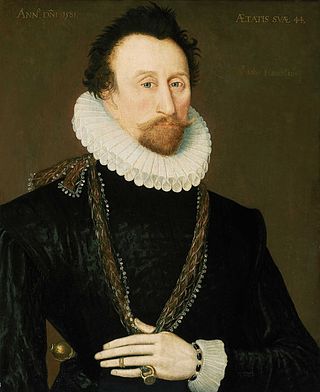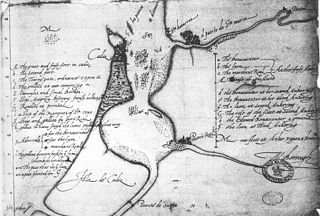
Sir Francis Drake was an English explorer and privateer best known for his circumnavigation of the world in a single expedition between 1577 and 1580. This was the first English circumnavigation, and third circumnavigation overall. Having started as a simple seaman, in 1588 he was part of the fight against the Spanish Armada as a vice-admiral.

Buccaneers were a kind of privateer or free sailors particular to the Caribbean Sea during the 17th and 18th centuries. First established on northern Hispaniola as early as 1625, their heyday was from the Restoration in 1660 until about 1688, during a time when governments in the Caribbean area were not strong enough to suppress them.

A privateer is a private person or vessel which engages in maritime warfare under a commission of war. Since robbery under arms was a common aspect of seaborne trade, until the early 19th century all merchant ships carried arms. A sovereign or delegated authority issued commissions, also referred to as letters of marque, during wartime. The commission empowered the holder to carry on all forms of hostility permissible at sea by the usages of war. This included attacking foreign vessels and taking them as prizes and taking crews prisoner for exchange. Captured ships were subject to condemnation and sale under prize law, with the proceeds divided by percentage between the privateer's sponsors, shipowners, captains and crew. A percentage share usually went to the issuer of the commission.

A letter of marque and reprisal was a government license in the Age of Sail that authorized a private person, known as a privateer or corsair, to attack and capture vessels of a nation at war with the issuer. After capturing, the privateers could bring the case of that prize before their own admiralty court for condemnation and transfer of ownership to the privateer. A letter of marque and reprisal would include permission to cross an international border to conduct a reprisal and was authorized by an issuing jurisdiction to conduct reprisal operations outside its borders.

Admiral Sir John Hawkins was an English naval commander, naval administrator, privateer and slave trader.

The Anglo-Spanish War was a conflict between the English Protectorate under Oliver Cromwell, and Spain, between 1654 and 1660. It was caused by commercial rivalry. Each side attacked the other's commercial and colonial interests in various ways such as privateering and naval expeditions. In 1655, an English amphibious expedition invaded Spanish territory in the Caribbean. In 1657, England formed an alliance with France, merging the Anglo–Spanish war with the larger Franco-Spanish War resulting in major land actions that took place in the Spanish Netherlands.

The Anglo-Spanish War (1585–1604) was an intermittent conflict between the Habsburg Kingdom of Spain and the Kingdom of England that was never formally declared. It began with England's military expedition in 1585 to what was then the Spanish Netherlands under the command of the Earl of Leicester, in support of the Dutch rebellion against Spanish Habsburg rule.

Edward Davis or Davies was an English buccaneer active in the Caribbean during the 1680s and would lead successful raids against Leon and Panama in 1685, the latter considered one of the last major buccaneer raids against a Spanish stronghold. Much of his career was later recorded by writer William Dampier in A New Voyage Round the World (1697).
Sir Michael Geare was a 16th-century English sailor, privateer and merchant. One of the many Sea Dogs who plagued the Spanish Empire during the Elizabethan age, Geare was well known to the Spaniards of the West Indies and the Spanish Main as commander of the Little John. He remained one of the most active in the region throughout the 1590s and up until his retirement in 1603.

Singeing the King of Spain's Beard is the derisive name given to a series of attacks by the English privateer Francis Drake against the Spanish in the summer of 1587, beginning in April with a raid on Cádiz. This was an attack on the Spanish naval forces assembling in the Bay of Cádiz in preparation for the planned expedition against England. Much of the Spanish fleet was destroyed, and substantial supplies were destroyed or captured. There followed a series of raiding parties against several forts along the Portuguese coast. A Spanish treasure ship, returning from the Indies, was also captured. The damage caused by the English delayed Spanish preparations for the Armada by at least a year.

The Sea Dogs were a group of English privateers and explorers authorised by Queen Elizabeth I to raid England's enemies, whether they were formally at war with them or not. Active from 1560 until Elizabeth's death in 1603, the Sea Dogs primarily attacked Spanish targets both on land and at sea, particularly during the Anglo-Spanish War. Members of the Sea Dogs, including Sir John Hawkins and Sir Francis Drake, also engaged in illicit slave trading with Spanish colonies in the Americas.
Sir John Watts was an English merchant, Alderman and shipowner, active in the East India Company and Virginia Company and Lord Mayor of London in 1606.

The Capture of Portobello was a military event during the Anglo–Spanish War in which an English expedition under the command of William Parker assaulted and took Portobello from the Spanish, acquired some booty, and then sacked the place.

The Battle of Cartagena de Indias (1586) or the Capture of Cartagena de Indias was a military and naval action fought on 9–11 February 1586, of the recently declared Anglo-Spanish War that resulted in the assault and capture by English soldiers and sailors of the Spanish colony city of Cartagena de Indias governed by Pedro de Bustos on the Spanish Main. The English were led by Francis Drake. The raid was part of his Great Expedition to the Spanish New World. The English soldiers then occupied the city for over two months and captured much booty along with a ransom before departing on 12 April.
The Raid on Puerto Caballos was a military event that took place during the Anglo–Spanish War where a small expedition of ships funded and raised by the Earl of Cumberland was sent to the Caribbean under command of Captain James Langton. At Puerto Caballos on the coast of the Royal Audiencia of Guatemala in the New World empire of Spain on 16 March 1594, Langton raided the place and after a three-day battle won possession of seven ships under command of Diego Ramirez along with much booty.

The Capture of Recife also known as James Lancaster's 1595 Expedition or Lancaster's Pernambucan expedition was an English military expedition during the Anglo–Spanish War in which the primary objective was the capture of the town and port of Recife in the Captaincy of Pernambuco in the Portuguese colony of Brazil in April 1595. An English expedition of ships led by James Lancaster sailed via the Atlantic capturing numerous prizes before he captured Recife. He held the place for nearly a month and then proceeded to defeat a number of Portuguese counterattacks before leaving. The booty captured was substantial, Lancaster chartered Dutch and French ships that were also present there thus making the expedition a military and financial success.

The Capture of Santiago was a military engagement that took place between 11 and 28 November 1585 during the newly declared Anglo-Spanish War. An English expedition led by Francis Drake captured the port town of Cidade Velha in the Cape Verde islands that had recently belonged to the Crown of Portugal. He sacked it and then marched inland before doing the same at São Domingos and Praia. Afterwards Drake left and continued his expedition to successfully raid the Spanish possessions in the Americas.

The Blockade of Western Cuba, also known as the Watts' West Indies Expedition of 1591, was an English privateering naval operation that took place off the Spanish colonial island of Cuba in the Caribbean during the Anglo–Spanish War. The expedition along with the blockade took place between May and July 1591 led by Ralph Lane and Michael Geare with a large financial investment from John Watts and Sir Walter Raleigh. They intercepted and took a number of Spanish ships, some of which belonged to a Spanish plate convoy of Admiral Antonio Navarro, and protected by the Spanish navy under Admiral Diego de la Ribera intending to rid English privateers. The English took or burnt a total of ten Spanish ships including two galleons, one of which was a valuable prize. With this success and the loss of only one ship the blockade and expedition was terminated for the return to England. The blockade was one of the most successful English expeditions to the Spanish Main during the war militarily and financially.

The Newfoundland Expedition also known as Bernard Drake's Newfoundland Expedition was an English naval expedition that took place during the beginning of the declared Anglo-Spanish War in the North Atlantic during summer and autumn of 1585. The area of conflict was situated mainly in an area known as the Grand Banks off present day Newfoundland. The aim of the expedition was to capture the Spanish and Portuguese fishing fleets. The expedition was a huge military and financial success and virtually removed the Spanish and Portuguese from these waters. In addition the raid had large consequences in terms of English colonial expansion and settlement.

Francis Drake's circumnavigation, also known as Drake's Raiding Expedition, was an important historical maritime event that took place between 15 December 1577 and 26 September 1580. The expedition was authorised by Queen Elizabeth I and consisted of five ships led by Francis Drake. Termed a 'voyage of discovery', it was in effect an ambitious covert raiding voyage and the start of England's challenge to the global domination of Spain and Portugal.
















